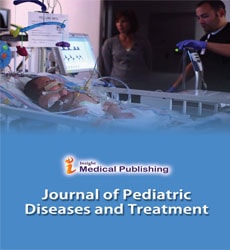An Unexpected ECG Finding in a Teen with Chest Pain
Victoria Wurster Ovalle, Holly R Hanson and Nathan Timm
Division of Emergency Medicine, Cincinnati Children's Hospital Medical Center, Cincinnati, USA
- *Corresponding Author:
- Victoria Wurster Ovalle
Division of Emergency Medicine
Cincinnati Children's Hospital Medical Center
3333 Burnet Ave, MLC 2008 Cincinnati, OH 45229
USA
Tel: +703-577-6550
E-mail: Victoria.WursterOvalle@cchmc.org
Received date: December 05, 2015; Accepted date: December 17, 2015; Published date: December 24, 2015
Citation: Ovalle WV, Hanson HR, Timm N. An unexpected ECG finding in a teen with chest pain. Pediatr Emerg Care Med Open Access. 2015, 1:1.
Abstract
A teenage girl presented to the Emergency Department (ED) with chest pain and shortness of breath. An electrocardiogram (ECG) showed sinus bradycardia with uniform asynchronous spikes. Her history was significant for gastroparesis status post gastric pacemaker implantation, with the cause of her asynchronous spikes being the electrical activity of her gastric pacemaker. ECG artifact secondary to a gastric pacemaker has rarely been described in the literature. Here, we present the first case of ECG artifact due to gastric pacemaker electrical activity in a pediatric patient.
Case
A 17-year old girl with a history of asthma, migraines, postural orthostatic tachycardia syndrome, hypermobility, gastroesophageal reflux and gastroparesis status post gastric pacemaker placement a year and a half prior presented to the ED with an acute onset of chest pain and shortness of breath. The symptoms started a few hours prior to arrival and had resolved en route to the hospital after administration of Albuterol by Emergency Medical Services for shortness of breath. Upon arrival to the ED she denied chest pain, palpitations, cough, shortness of breath, or fever. Vital signs showed a heart rate of 70 beats/ minute, respiratory rate of 16/minute, blood pressure of 118/60 mmHg, temperature of 36.7°C, and an oxygen saturation of 100% on room air. On exam she was alert and in no distress. Her lungs were clear with normal respiratory effort. She had no reproducible chest pain with palpation. Heart tones were regular, no murmur was appreciated, and she had strong pulses and brisk capillary refill. Her abdominal exam was notable for a gastric pacemaker palpated in her left lower quadrant. The remainder of the physical exam was unremarkable. An ECG was obtained (Figure 1) given her history of chest pain and was notable for sinus bradycardia to 48 (of note, prior Holter monitor recorded low heart rates in the 40 s, and previous ECGs with heart rates in the 50 s), early repolarization (a normal variant), and asynchronous spikes lasting a total of 2 seconds.
Discussion
This is the first report of electrical activity on a 12-lead ECG related to a gastric pacemaker in a pediatric patient. The few case reports that exist in the literature describe artifact in adult patients with concomitant cardiac concerns (including one with a cardiac pacemaker) and implanted gastric pacemakers for treatment of diabetic gastroparesis [1,2]. These pacemakers, or gastric electrical stimulators (GES) have been approved for use in drug-refractory gastroparesis since 2000 [3]. The device consists of a pulse generator implanted in the abdominal wall with typically two leads inserting into the muscularis propria of the stomach’s greater curvature, which is the site of natural pacemaker activity [4]. Electrical activity is low-amplitude and high-frequency (though a variety of set frequencies are possible), with “on” and “off” periods of activity to mimic physiologic gastric function [5]. In our patient’s case, the “on” period was 2 seconds, with an “off” period of 3 seconds, correlating with her ECG findings. We felt that this incidental finding was unrelated to her presenting symptoms.
While ECG artifact overall may be common, reports of artifact due to electrical stimulation devices is rare, and to gastric pacemakers even more so. Other electrostimulators that have caused documented artifact on ECG include thalamic, spinal cord, and peripheral nerve devices [6]. When obtaining an ECG in a patient with any of these devices, one should be aware of the potential electrostimulatory effect they may have when interpreting results.
Conclusion
We describe here a unique case of ECG artifact due to the electrical activity of a gastric pacemaker in a teenage girl. The use of electrical stimulator devices in the pediatric population is becoming more widespread. This case report highlights the importance of being able to recognize ECG artifact caused by an extra-cardiac electrical stimulator.
References
- IyerV, NazifTM, VazquezJ(2012) A most unusual pacemaker. PACE 35: 203-205.
- ReddyNK, Merla R, Pehlivanov N (2005)An unusual electrocardiogram artifact: what is its source? J Electrocardiology38:337-339.
- Humanitarian Device Exemption for EnterraDevice (2000) Federal Registry 65:78495-78496.
- Debas HT (2006)Gastrointestinal surgery: pathophysiology and management. pp: 48-49.
- McCarty TR, Rustagi T (2015) Endoscopic treatment of gastroparesis. World J Gastroenterol 21:6842-6849.
- Patel S, Souter M (2008)Equipment-related electrocardiographic artifacts: causes, characteristics, consequences, and correction. Anesthesiology 108:138-148.

Open Access Journals
- Aquaculture & Veterinary Science
- Chemistry & Chemical Sciences
- Clinical Sciences
- Engineering
- General Science
- Genetics & Molecular Biology
- Health Care & Nursing
- Immunology & Microbiology
- Materials Science
- Mathematics & Physics
- Medical Sciences
- Neurology & Psychiatry
- Oncology & Cancer Science
- Pharmaceutical Sciences

